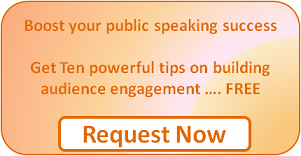|
How can you convert
a seminar to a keynote?
In the speaking world, the media
stars are the keynote speakers. A lot of seminar leaders and
trainers ask me how they can adapt their material to this
intense, high-profile, and often lucrative specialty.
* "The keynote speech comes from the discipline of show business. The seminar
comes from the discipline of teaching." Bill Gove, first president of the
National Speakers Association.
* "With a keynote speech, the presenter is the star. With seminars, the leader
needs to make the audience members the star." Don Thoren, past president
National Speakers Association and long-time seminar leader.
To understand the big difference between keynotes and seminars, start
by appreciating the unique characteristics of each. "Conversations occur in both
keynotes and seminars," explains my colleague David Palmer, Silicon Valley
management, seminar leader on Negotiations, and teacher of MBA students at Santa
Clara University. "In a seminar, attendees learn more when you get them to do
most of the talking. Your role is to set up the situations and guide them,
letting them teach each other. But with a keynote speech you are presenting a
conversation between you and each member of the audience. They are talking back
to you in their own heads. During your speech, ask questions, then pause while
the audience members think about what you have said."
You need to understand how they are likely to answer. Set up a conversation
between your voice and their heads and hearts. This is why a good keynote speech
has rich and well-developed stories. Stories take people on a journey in their
head. The stories are from your experience, and your audience relives them from
their own perspective. The amount of learning is not going to be as deep as in a
seminar, but the result of a good keynote can still be very profound. When well
done, both keynotes and seminars can sell other services.
What are the differences?
* Keynote speeches are much shorter than seminars. Therefore, you have far less
time to get to the point and have an impact.
* Client expectations increase with fee and size of audience.
* The performance aspect has to be more refined. You may be IMAGed, so you
can't pace around. It's like the difference between movie acting and stage
acting.
* Audiences are considerably larger. If you are accustomed to speaking to
twenty to fifty people, facing thousands can be daunting.
* When done superbly, a keynote speech looks easy. That's why so many think,
"Gee, I could do that." Don't be fooled!
How do I condense my material?
As a seminar leader, you might think, "I can't say anything in only an hour!"
Get over it! If you can't say anything worth listening to in five minutes, you
do not deserve an hour, let alone a two-day seminar. (And even when you are
booked for an hour keynote, there is a good chance your time will be cut!)
Here's how to condense your material.
1. Start with the key subject of your training.
2. Define your premise or central theme (as briefly as possible).
3. Write it in a way that will encourage the audience to be asking how or
why.
4. Make their mental questions and your answers your talking points.
5. Support each talking point with vivid stories and examples.
6. Conclude with a recommendation or call for some sort of action.
You can then adapt your material for different audiences. For example:
Your subject: Speaking Skills.
Your title: How to Design and Deliver More Charismatic Sermons.
Your audience: Seventh-day Adventist pastors.
Your premise: "Every Seventh-day Adventist pastor can deliver even more
charismatic sermons."
Audience asks themselves: "How?"
Your answer: "By better understanding and implementing three necessary
ingredients in every talk or sermon."
Audience asks themselves: "What are they?"
Your answer: "Structure, content, and delivery...Your content needs to connect
with your audience two ways."
Audience asks themselves: "What are they?"
Your answer: "Intellectual and emotional...There are three ways to connect
emotionally."
Audience asks themselves: "What are they?"
Can you see what my colleague David Palmer means about creating questions in
the audience's mind and then answering them?
Some Other Tips:
Use stories. Help your audience to connect with characters that make your
points accurately and memorable. In a keynote, these stories have to be
condensed to the nub. Cut out all waffle and fluff.
Use dialogue. Make the audience feel as if they are there as part of the
situation you are talking about.
Create an intimate bond by speaking to the group as one person: "Do YOU
think...?" Everyone feels you are talking directly to them.
Rehearse, don't read. A keynote requires a great deal of practice. It's okay to
have a few notes, but never work from a handout or workbook as you might have in
your seminar.
Start with high impact. Never do "housekeeping details" at the beginning.
Close on a high note so you'll be remembered.
TELESEMINAR
http://www.speakerlauncher.com/teleclass.fripp.html
Patricia Fripp is an in-demand speech coach and sales presentation skills
trainer. Keynotes and Presentation Descriptions:
http://www.fripp.com/forplanner.html
More articles on speech
preparation
|
|
Business
Speaking

build
your client base
promote
your products/services
improve your bottom line
>>> |
| |
|
Corporate/Leadership
Speaking

career
success
management communication
leadership skills
>>> |
| |
|
Functions/Events
Speaking

speak smoothly,
confidently
and from the heart
help create the
special day
>>> |
|
|
 |
|